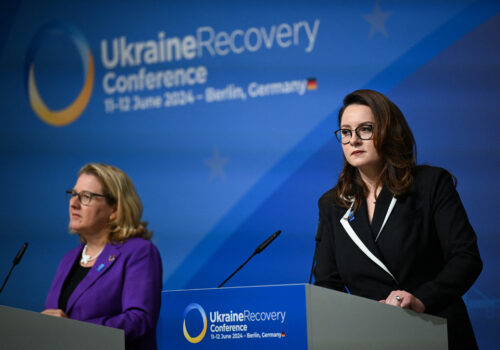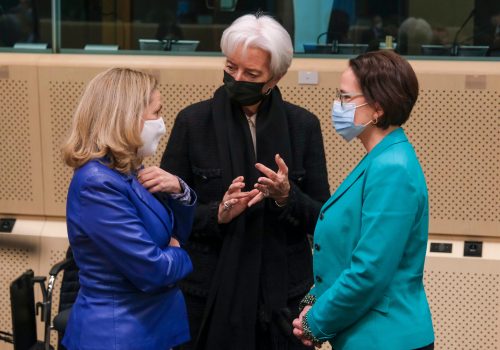Charting the path for women’s economic security in the G20
This Saturday is International Women’s Day, so it’s a good time to take stock of how the world’s largest economies are actually doing on gender equality. The picture that emerges is not exactly cause for celebration—but does highlight where the Group of Twenty (G20) needs to focus its attention.
As a forum specifically created to address shared economic challenges, the G20 is critical for accelerating progress on issues of women’s economic empowerment and security. The group’s efforts are especially relevant since compounding crises in recent years have exposed existing economic inequalities. Research shows that working women experienced worse effects from the COVID-19 recession—unlike previous economic downturns that predominantly affected men. In September 2021, women were 2.4 times more likely than men to report losing paid work in order to care for others. Pursuing gender-inclusive policies is critical for achieving collective prosperity and sustainable development.
The United States is set to take over the G20 presidency in 2026. If the United States puts gender empowerment high on the agenda, it can help deliver growth both at home and around the world. Despite recent efforts in the G20, there is still a lot of work to be done to address inequalities and promote progress for women.
Here are five charts that demonstrate these persisting economic gaps:
The Women Peace and Security (WPS) Index measures progress on gender equality on thirteen indicators across three dimensions—inclusion, justice, and security. These indicators include maternal mortality rate, intimate partner violence, employment, and financial inclusion. While most G20 countries have made progress since the start of the index in 2017, the story looks different when we take a closer snapshot.
From 2021 to 2023, almost all G20 countries experienced significant backsliding, according to the WPS Index. This regression was primarily driven by the uneven recovery from the COVID-19 pandemic, which triggered global economic recessions and was further compounded by conflicts in Europe and the Middle East. These crises exposed and exacerbated existing economic inequalities, with women often bearing the brunt of the negative impact. According to research from 2022, the COVID-19 pandemic set gender parity back by a generation, with weak recovery making it even more difficult.
Notably, this decline was not limited to emerging economies. Advanced economies such as the United States, Canada, and European G20 members also recorded substantial downgrades in gender equality indicators. In these advanced economies, women faced increased unpaid domestic burdens, higher rates of unemployment, and diminished access to childcare services. Even countries with robust social safety nets and gender equality frameworks proved vulnerable to systemic shocks. This all underscores that the G20’s collective commitment to gender equality requires stronger, crisis-resistant policy instruments specifically designed to protect women’s economic security.
In 2018, the IMF noted that no advanced or middle-income economy achieved less than 7 percent in the gender labor force participation gap. Six years later, only France and Canada have managed to reduce that rate to below 7 percent within the G20.
The gap in labor force participation can reflect social and cultural norms, but it can also represent the structural barriers that women face in the labor market, including access to quality education or equitable hiring practices. Gender inclusion in the labor force is important because when a country has a more diverse pool of talent and fully taps into its available human capital, it generates better economic results for everyone, including increased GDP growth, reduced income inequality, and improved overall economic productivity.
Yet within formal employment, wage disparities between women and men have remained a persistent driver of inequality. In the United States, women earn only eighty-four cents for every dollar earned by a man, and globally, the gender pay gap is still approximately 20 percent. In fact, the United States ranks among the bottom five G20 countries when it comes to gender-based wage inequality.
On average around the world, women reinvest more of their income in their families, influenced by the care burden that many women shoulder for children or the elderly. Pay inequality directly impacts these families’ financial stability, housing options, educational opportunities, and quality of life. Progress to narrow this gap has been frustratingly slow. While equal pay has been widely endorsed in principle, implementing it effectively has proven challenging.
For the G20 specifically, addressing wage inequality represents both an economic imperative and a moral obligation. Studies consistently show that reducing gender wage gaps boosts GDP, increases tax revenue, and enhances business performance through greater diversity.
Only 12.3 percent of finance ministers and central bank governors across over 185 countries are women. This is more than 10 percent lower than the average proportion of women represented in cabinet members globally. This disparity is driven by a few factors, such as male dominance in the study of economics, barriers that prevent women from being promoted, and social perceptions of women’s abilities.
The G20 fares a little better than this global percentage with three female central bank governors and five female finance ministers. However, overall economic empowerment and security for women will be tougher to achieve when gender parity and inclusivity are still lacking in global economic leadership. The G20 should be the forum where the world’s major economies can convene and commit to achieving gender-balanced economic results.
The path forward
Addressing these gender gaps would have positive economic impacts globally. Women’s participation in the formal labor force increases economic diversification and drives income equality. Moody Analytics estimated that closing the gender gap could boost the global economy by seven trillion dollars. While there’s no silver bullet solution that would be able to fix these disparities overnight, there are a series of policies that could help, such as improving educational opportunities or equitable hiring practices.
There is a risk that women’s economic empowerment will not be a key focus for the G20. Leading the group next year, the United States has an opportunity to guide the global conversation by showing how investing in women creates resilient economies that benefit everyone.
Alisha Chhangani is an assistant director with the Atlantic Council GeoEconomics Center.
Jessie Yin is an assistant director with the Atlantic Council GeoEconomics Center.

At the intersection of economics, finance, and foreign policy, the GeoEconomics Center is a translation hub with the goal of helping shape a better global economic future.
Further reading
Fri, Jun 14, 2024
Women should play a central role in rebuilding Ukraine’s economy
New Atlanticist By
Ukraine can only rebuild its economy if women and civil society are fully involved in its reconstruction efforts.
Fri, Mar 8, 2024
Investing in women accelerates prosperity and peace
New Atlanticist By Nicole Goldin
Expanding opportunities for women is essential for economic resilience and recovery during and after conflicts.
Fri, Jun 2, 2023
Only 11 percent of finance ministers and central bank governors are women
Econographics By
Some of the most powerful economic institutions in the world are led by women at the moment, but their success hasn’t translated to broad representation. Structural barriers continue to prevent many women from reaching top roles in finance and economics.


